In this post we’re going to continue our “journey” with MKPs (MAP kinase phosphatases).
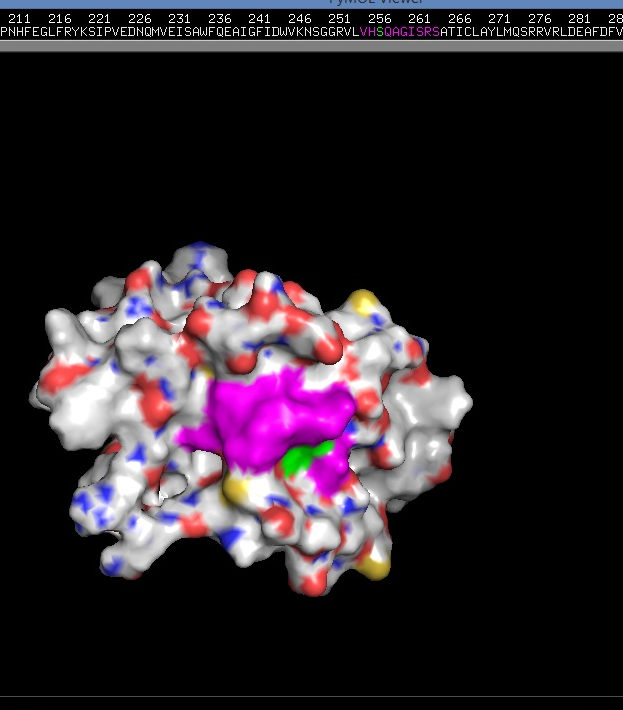
(DUSP2 catalytic domain (surface representation) with its conservative (V)-HC-XX-X-XX-R-(S/T) motif (highlighted with magenta). 3D-structure (PDB-file) - 1M3G in this case - was obtained from PDB. The image was created by me with the help of PyMol - open source tool for molecules visualization/exploration. You can use the image if you want).
Feel free to leave comments related to the topic of this post (or this series of posts). As I mentioned in the introduction post for this series, I’m not a professional bioinformatician/biochemist, so if you see any mistakes or have a question, go ahead.
Before we begin to investigate actually possible ways Cd2+ could “use” to influence MKPs (hence MAPK signalling pathway), let’s try to investigate Cd2+ relationship with MKPs using another approach. We’ve found out in the first part of this series that Cd2+ affects MAPK-signalling pathway [1].
Great. But MAPK signalling pathway is one of the best studied signalling pathways ever [2]. And you, probably, remember from the first part, how scary all that looks. What if we would like to narrow down the list of MKPs cadmium could have impact on, or what if we wouldn’t have the data we’ve got from the articles/papers/monograph. As it was mentioned in the first part, MAPK signalling includes MAPK kinase kinases (MKKK or MEKK), MAPK kinases (MKK or MEK) and MAPKs themselves [6].
Knowing what genes products exactly of the MAPK pathway are influenced by Cd2+ also would help us to understand, if Cd2+ could influence MKPs at all. Because if the list of genes/genes products influenced by Cd2+ includes all kinases except for MAPK themselves (which are the only ones (according to that image on KEGG) regulated by MKPs), then Cd2+ should not influence MKPs (what might dash our hopes for/ruin the whole idea of the first experiment).
We saw in the first part, that the range of DUSPs which can regulate ERK (also known as MAPK1) and ERK1 (MAPK3) ([3]) includes DUSP1, DUSP2, DUSP4, DUSP5, DUSP6, DUSP7, DUSP8, DUSP9, DUSP10 and, finally, DUSP16 (10 DUSPs in total).
And the range of DUSPs which can regulate JNK (also known as MAPK8), MAPK9, MAPK10 ([4]) and p38 (also known as MAPK14), MAPK11, MAPK12 and MAPK13 ([5]) includes all of the DUSPs above except for DUSP1 and DUSP6 (8 in total).
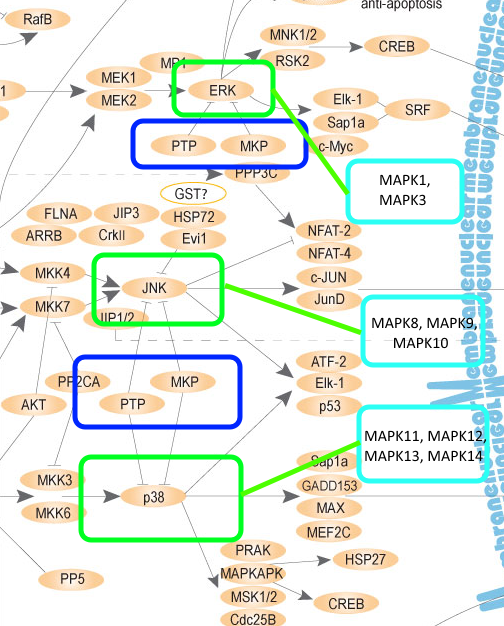
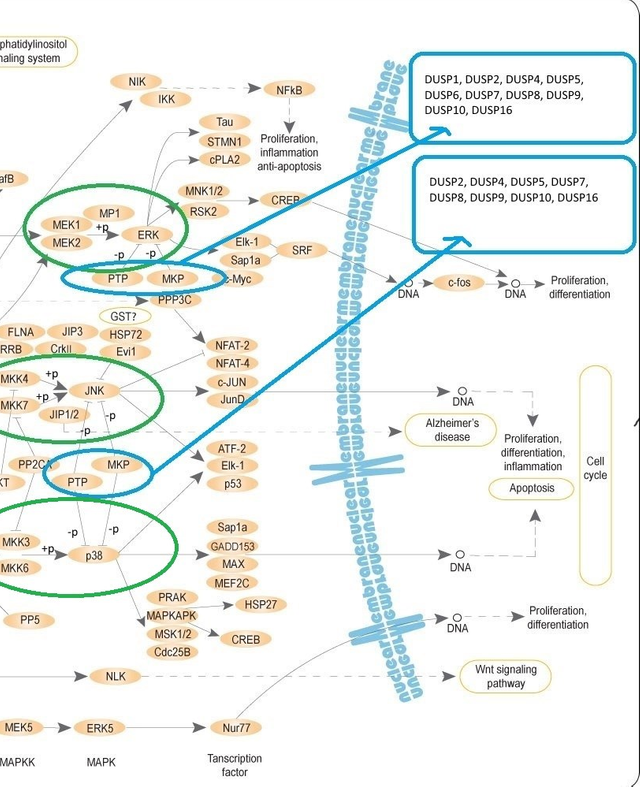
Well, it doesn’t look like a big difference (10 or 8), but imagine if the difference in your particular case with another signalling pathway and proteins was something like 7 and 54 for example.
So, let’s try to narrow down that list of MKPs we might be interested in (and again, we’re interested in those which could be somehow indirectly (or directly) affected by Cd2+.
The logic here is as follows:
If we know what MAPKs genes/genes products exactly of those mentioned above are influenced by Cd2+, we could narrow down the list of MKPs (or, if no MAPKs genes get activated, then we could exclude the possibility that Cd+2 could influence MKPs at all (which would actually dash our hopes and the reason to do all this first Exp.)).
Of course, we could try to analyze the literature (dozens of papers/articles) searching for the answer – what MAPKs exactly are influenced by Cd2+ (and again, if they are influenced by it at all). But, as it was said in the introduction of this series of posts, bioinformatics might help us to save a lot of time. So, let’s leverage its power and try to figure out what MAPKs/MKPs genes are influenced by Cd2+ by carrying out ontological analysis.
Also, probably, there’s just no such information in the literature yet (what MAPKs are influenced by Cd2+), but it might be in the databases developed for biologists/bioinfomaticians.
And, finally, some literature (especially monographs) might just cost a lot (and all databases, I’ve seen so far, were freely available).
Now, let’s try to figure out what ontological analysis is. But before that let’s try to figure out what ontology is. In the philosophical context it’s the study of being (answering the questions like “What is existence?”, “What does it mean to exist?”) [7].
The best definition I could give with my own words as for now for “ontology” in the context of science is
Ontology is the group of concepts/ideas/terms we should use to describe something, which help us to organize information into knowledge and exchange it [8].
And Gene Ontology (GO) is an initiative/project which deals with, obviously, genes and genes products, and tries to provide scientists those concepts/ideas/terms. For example, it provides vocabulary we should use to describe proteins (so that scientists could unambiguously understand each other). And those concepts/ideas/terms are grouped into 3 main fields: cellular component, molecular function (that gene products do) and biological process (where those products participate) (so that we have 3 ontologies). Each term has a unique identifier, and all terms are organized into a hierarchical structure (graph) (with parent-child relationships) [9, 10].
All this stuff is provided by Gene Ontology (GO) Consortium.
And then all that is used by Gene Ontology Annotation (GOA) project to annotate (document) genes products as manually, as electronically/automatically.
We (biologists) might get access to all that (ontological terms (provided by Gene Ontology (GO) Consortium) and annotations (provided by Gene Ontology Annotation (GOA))) with the help of web-interface - QuickGO browser for example (kind of Google search for bioinformaticians) [11].
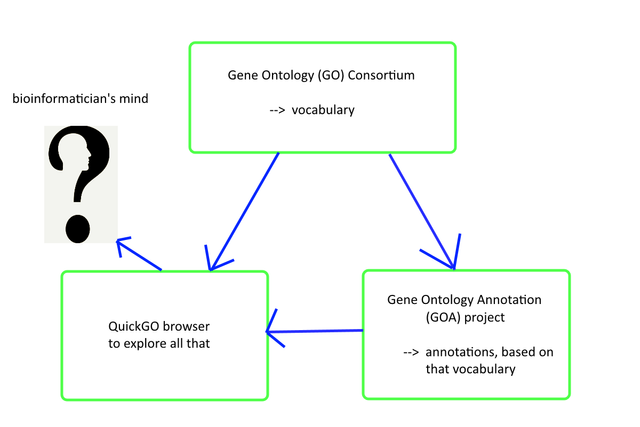
And, finally, I could describe ontological analysis as the process of finding information about genes/genes products using those ontologies/web-interfaces.
Anyway, all this should become much clearer in practice.
|| Useful tip
we could try to use Steemit as an analogy here. Just like you can see on Steemit specific spots with terms (n followers | n posts | n following (where n is the number), Name (reputation), wallet…) populated with information specific for each user/Steemian, you can see on QuickGO spots with specific terms, populated with information specific for each gene/gene product.
Getting the list of genes related to the cellular response to cadmium ion
What we are going to do now is to go to QuickGO website and search for “cadmium” [14].
What we are interested on results page is “cellular response to cadmium ion” term (you’ll see a button saying “1,745 annotations” (at the time of writing (May, 2019)) near it).
Click that button and wait for results. Now, you can click “GO terms” button. There you’ll see “cellular response to cadmium ion” with an icon (parent-child relationship), click that icon. A special modal window will appear with the hierarchical structure indicating where “cellular response to cadmium ion” (GO:0071276) term is located. Then you can click on it, and a page dedicated specifically to that term will be opened. On that page you can see that this term has child terms like “cellular detoxification of cadmium ion” and “SCF complex disassembly in response to cadmium stress”. Also you can see a clear definition for “cellular response to cadmium ion” term. We chose “cellular response to cadmium ion” result on that QuickGO results page for “cadmium” search, because it’s the most common term (parent) in our case (well, it’s almost the most common term, because we also can see “response to cadmium ion” term as its parent but we are interested in “cellular response”).
Now, click “Taxon” button on the page with annotations for “cellular response to cadmium ion” term and choose “Homo sapiens”, click “Apply” (at the bottom of the modal window). As a result our 1,745 annotations narrow down to 59. Now click an “Aspect” button and choose “biological process” option and click “Apply”.
As it was mentioned above genes products can be annotated manually (by experts) and automatically (by computers). Now click an “Evidence” button. There you can choose the evidence code you need. For more information on this go to geneontology [12].
Well, I used QuickGO several years ago. At that time there was an “Inferred from Electronic Annotation (IEA)” option in that “Evidence” window [13]. So, as far as I understand, now that option is not there, and according to QuickGO FAQ page “All manual codes” higher-level grouping (the parent for all manual annotation evidence codes) has an ECO:0000352 (“evidence used in manual assertion” in our “Evidence” window). So, we can just choose that to include all manual annotations. Then click “Apply”. But if you would want to also see annotations added by computers automatically, then, as far as I understand, you need to add an “Inferred from Electronic Annotation (IEA)” option (with “add” button in the “Evidence button”).
After applying all those filters we now have just 42 annotations. All we have to do now is to export our data. But before that let’s click “Customise” option. In the window appeared let’s leave just “Symbol” and “Evidence” options. Click “Customise” again to remove the window. Finally, click “Export” button, choose “Tab-delimited” (tab-separated values/TSV) format and click “Go”.
|| Useful tip
Now, if you open the exported file with .tsv extinction with Excell, you’ll see that all your results are located in just 1 cell (it’s just a chaos). But, if you open that tsv-file in Notepad, copy all the data there and paste them into that same Excell, you’ll see that all pieces of the data are in separate cells. Looks like by copying data initially to Notepad we remove some formatting information.
So…
Finally we have a list of genes (“SYMBOL” column) (we see 42 genes, but there are just 29 unique genes) related to “cellular response to cadmium ion”. And we can already see MAPK1, MAPK3, MAPK8 and MAPK9 among them.
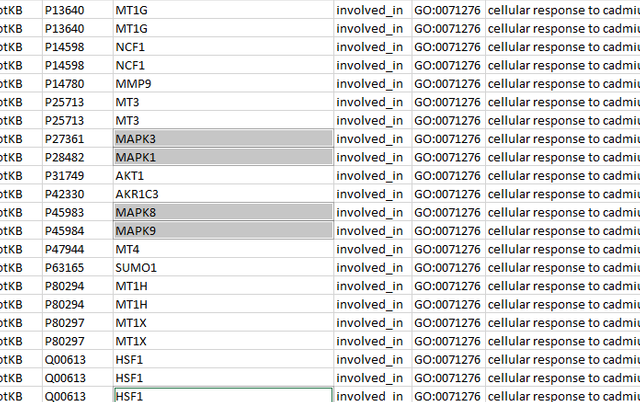
( The image above shows the part of the list of genes related to the “cellular response to cadmium ion” term. The genes were taken with the help of QuickGO. The image was created by me. You can use it if you want)
In the next part (Part 3. B) we're going to find biological processes in which the genes we've got in this post are involved in with the help of GeneCodis and discuss in detail results of all we've done in this (3rd) part.
Other posts of this series:
Bioinformatics experiments. Introduction
References:
Sigel, Astrid, Sigel, Helmut, Sigel, Roland K. O. (Eds.).
Cadmium: From Toxicity to Essentiality. 2013, XXXVI, 560 p. 128 illus., 43 illus;
Hey Alex,
thanks for continuing the series. And thanks for the good approaches you have, such as "saving time by browsing bioinformatic databases". I also had a similar approach at the end of my Ph.D. thesis. The most experiments were done and I had no time left. But there were some questions left, thus I had a comparable technique to figure that out. Without exact knowledge, it was possible to answer many many aspects within a few weeks.
I don't know exactly what you are doing but if you want to make more concerning this I would also appreciate seeing something about Systems biology.
So far have a nice week.
Steem on!
Chapper
Downvoting a post can decrease pending rewards and make it less visible. Common reasons:
Submit
Hi.
agree about time-saving function of bioinformatics.
As for Systems biology, well, I heard that phrase once, but I've never investigate that.
I've just look into it on Wikipedia, that's very interesting!
If I have something to present about it, I will in the future.
Also I'd like to ask a question about SteemStem app (steemstem.io).
I wish to give some benefecearies of my posts to steemstem account
for the opportunity the gave people here, but I can't.
I've tried to publish my posts from there, but I constantly get an error message
under the editor there.
---> fc::raw::pack_size(trx) <= (get_dynamic_global_properties().maximum_block_size - 256):
Maybe you know what this might be the problem.
I suppose that it's about the length of the post.
So, should I then make my posts shorter?
Or maybe that error is about the length of the title of my posts or something else.
Downvoting a post can decrease pending rewards and make it less visible. Common reasons:
Submit
Hey there, unfortunately I have no answer. But you can mention this in Steemstem chat. Further, you can contact @justtryme90, @lemouth or @mobbs directly.
Thank you for supporting steemstem.
Have a great day
Chapper
Posted using Partiko Android
Downvoting a post can decrease pending rewards and make it less visible. Common reasons:
Submit
Nice work here showing how a simple bioinformatic analysis can provide a lot of information. I'm looking at your list of 42 hits and you may be able to discount some entirely (HSF1 may be a heat shock protein and those always show up in searches for example) while others seem to be duplicates.
Either way real cool stuff!
Downvoting a post can decrease pending rewards and make it less visible. Common reasons:
Submit
hi
yes, there're 42 genes showed up in my case and a lot are duplicates, just 29 are unique.
What I knew based on the literature (papers/articles) is that Cd2+ somehow impact MAPK-signalling.
QuickGO helped to figure out what MAKPs exactly were involved in response to Cd2+ (MAPK1,3,8,9 in this case).
agree about HSF1.
thanks
Downvoting a post can decrease pending rewards and make it less visible. Common reasons:
Submit
This post has been voted on by the SteemSTEM curation team and voting trail. It is elligible for support from @curie and @utopian-io.
If you appreciate the work we are doing, then consider supporting our witness stem.witness. Additional witness support to the curie witness and utopian-io witness would be appreciated as well.
For additional information please join us on the SteemSTEM discord and to get to know the rest of the community!
Please consider setting @steemstem as a beneficiary to your post to get a stronger support.
Please consider using the steemstem.io app to get a stronger support.
Downvoting a post can decrease pending rewards and make it less visible. Common reasons:
Submit
Hi @alexbiojs!
Your post was upvoted by Utopian.io in cooperation with @steemstem - supporting knowledge, innovation and technological advancement on the Steem Blockchain.
Contribute to Open Source with utopian.io
Learn how to contribute on our website and join the new open source economy.
Want to chat? Join the Utopian Community on Discord https://discord.gg/h52nFrV
Downvoting a post can decrease pending rewards and make it less visible. Common reasons:
Submit
Congratulations @alexbiojs! You have completed the following achievement on the Steem blockchain and have been rewarded with new badge(s) :
You can view your badges on your Steem Board and compare to others on the Steem Ranking
If you no longer want to receive notifications, reply to this comment with the word
STOPVote for @Steemitboard as a witness to get one more award and increased upvotes!
Downvoting a post can decrease pending rewards and make it less visible. Common reasons:
Submit